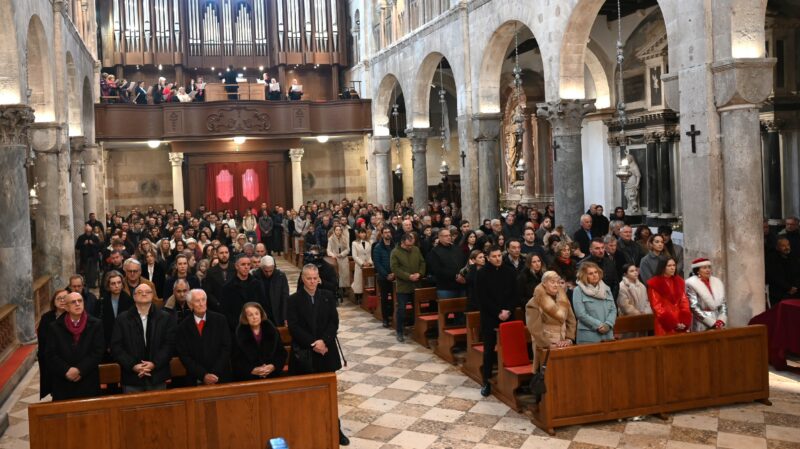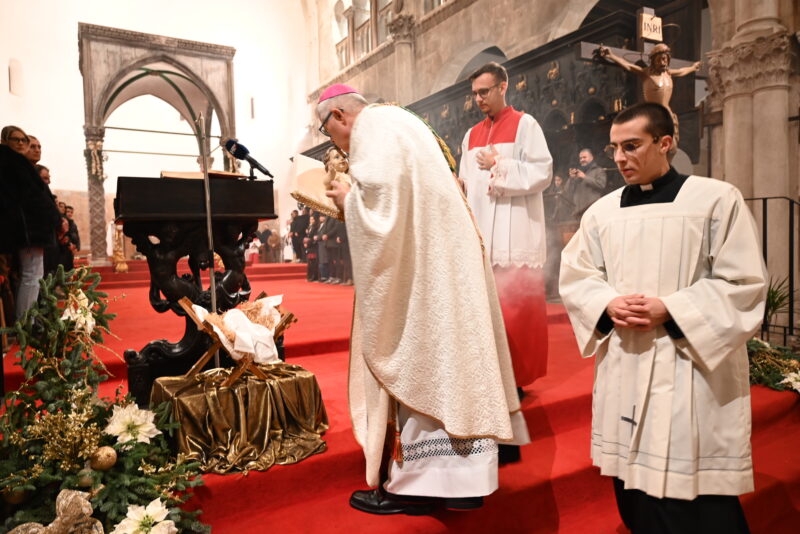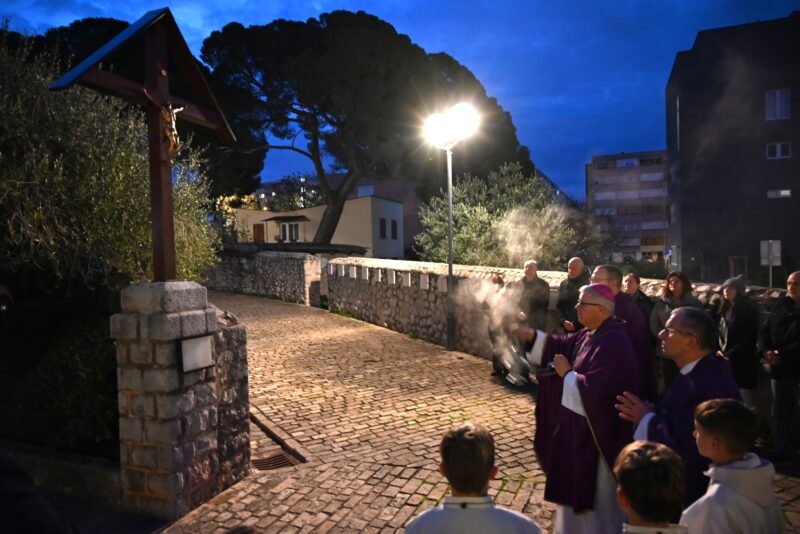O katedrali
Izaberi jezik | Choose a language
- HRVATSKI
- ENGLISH
- DEUTSCH
- ITALIANO
- FRANÇAIS
- PORTUGUÊS
- РУССКИЙ
- MAGYAR
- POLSKI
- ESPAÑOL
O katedrali sv. Stošije
„Trogirska katedrala je za razmatranje,
šibenska za gledanje,
a zadarska za doček kraljeva“
Ljubo Karaman (1886.-1971.), povjesničar umjetnosti
Početak gradnje prve zadarske katedrale (bazilike) može se datirati u 4. st., kada se spominje i prvi biskup Feliks. Bazilika je sagrađena neposredno uz glavni gradski trg – rimski Forum. Najprije je bila posvećena sv. Petru, a nakon što su u 9. stoljeću relikvije sv. Stošije došle u Zadar, katedrala nosi njezino ime.
Tijekom 12. stoljeća poprimila je svoj romanički stil, uz sačuvane dimenzije stare bazilike. No, nakon što je 1202. godine u Mletačkom osvajanju Grada stradala i katedrala, tijekom obnove je produžena i povišena. Od 13. stoljeća do danas katedrala nije bitno primijenila svoj vanjski izgled, što je čini vrlo jedinstvenom i posebnom građevinom u ovom dijelu Europe.
Bizantski car Konstantin Porfirogenet posjetio je katedralu u 10. stoljeću i opisao u svom djelu „O upravljanju državom“ kao bogato ukrašenu baziliku s lijepim slikama i podnim mozaikom.
Katedrala je bogata oltarima, antičkim stupovima, sačuvanim freskama… Iznad glavnog oltara nalazi se mramorni ciborij iz 14. stoljeća, a u prezbiteriju korska sjedala iz 15. stoljeća. Ispod prezbiterija nalazi se kripta iz 12. stoljeća. U sjevernoj lađi nalaze se relikvije sv. Anastazije, a u južnoj ulaz u sakristiju, odnosno nekadašnju kapelu sv. Barbare koja je u ranokršćansko vrijeme bila prostor gdje su se katekumeni pripremali za krštenje o čemu svjedoči i podni mozaik iz 5. stoljeća. Uz katedralu je vezana i krstionica u kojoj se nalazi osmerokutni krsni zdenac iz 12.
About the cathedral
“Trogir Cathedral is to be pondered upon,
that of Šibenik to be seen,
and that of Zadar to greet kings.”
Ljubo Karaman (1886-1971), art historian
Start of construction of the Zadar Cathedral (basilica) can be dated to the 4th century, when there is also mention of the first bishop, Feliks. The basilica was built right next to the city’s main square, the Roman Forum. In the beginning it was dedicated to St. Peter, but ever since receiving the relics of St. Anastasia the cathedral has carried her name.
The cathedral gained its Romanesque style during the 12th century while conserving its basilic-like dimensions. Although the cathedral suffered a tremendous ruin during the venetian conquest of the city of Zadar in 1202, it was restored during which process it was made longer and taller. From the 13th century until today the design of the cathedral hasn’t significantly changed which is what makes it such a unique and special creation in this part of Europe.
The Byzantine emperor Constantine VII Porphyrogenitus visited the cathedral in the 10th century and described it in his work “On the Governance of the Empire” as a richly decorated basilica with beautiful paintings and floor mosaics.
The cathedral is ample with altars, ancient columns, preserved frescoes, etc. Above the high altar is a marble ciborium from the 14th century, and in the chancel, choir seats from the 15th century. Under the presbytery there is a crypt from the 12th century. In the northern nave are the relics of St. Anastasia, and in the south the entrance to the sacristy, that is, the former chapel of St. Barbara, which in early Christian times was the place where catechumens prepared for baptism, as evidenced by the floor mosaic from the 5th century. Attached to the cathedral is the baptistery, which houses a 12th-century octagonal baptismal font.
Über die Kathedrale
“Die Kathedrale von Trogir ist zum Betrachten,
die Kathedrale von Šibenik zum Anschauen,
und die Kathedrale von Zadar zum Empfang von Königen.”
Ljubo Karaman (1886-1971), Kunsthistoriker
Der Beginn des Baues der Kathedrale (Basilika) von Zadar kann auf das 4. Jh. datiert werden, in dem auch der erste Bischof namens Felix erwähnt wird. Die Basilika wurde direkt neben dem Hauptplatz der Stadt, dem Forum Romanum, errichtet. Ursprünglich war sie dem heiligen Petrus geweiht, aber nachdem im 9. Jh. die Reliquien der heiligen Anastasia nach Zadar gekommen waren, trägt sie deren Namen.
Die Kathedrale erhielt ihren romanischen Stil im 12. Jahrhundert, wobei die Ausmaße der alten Basilika aber erhalten blieben. Bei der venezianischen Eroberung der Stadt Zadar im Jahr 1202 wurde sie stark zerstört und anlässlich der späteren Restaurierung in Länge und Höhe erweitert. Seit dem 13. Jahrhundert hat sich das äußere Erscheinungsbild der Kathedrale nicht wesentlich verändert, was sie zu einem einzigartigen und besonderen Bauwerk in diesem Teil Europas macht.
Der byzantinische Kaiser Konstantin VII. Porphyrogenitus besuchte die Kathedrale im 10. Jahrhundert und beschrieb sie in seinem Werk „Über die Verwaltung des Reiches“ als eine reich verzierte Basilika mit schönen Malereien und Bodenmosaiken.
Die Kathedrale ist reich an Altären, alten Säulen und gut erhaltenen Fresken. Über dem Hauptaltar befindet sich ein marmornes Ziborium aus dem 14. Jh. Das Chorgestühl im Chorraum ist aus dem 15. Jh. und die Krypta unter dem Presbyterium wurde im 12. Jh. angelegt. Im nördlichen Kirchenschiff finden wir die Reliquien der hl. Anastasia und im südlichen ist der Eingang zur Sakristei, bzw. zur ehemaligen Kapelle der hl. Barbara, die in frühchristlicher Zeit zur Vorbereitung der Katechumenen auf die Taufe diente, wie das Bodenmosaik aus dem fünften Jahrhundert bezeugt. An die Kathedrale angegliedert ist das Baptisterium mit einem achteckigen Taufbecken aus dem 12. Jh.
La cattedrale di Sant’Anastasia
“La cattedrale di Trogir è da meditare,
quella di Sebenico da vedere,
e quella di Zara per ricevere i re”.
Ljubo Karaman (1886-1971), storico dell’arte
L’inizio della costruzione della cattedrale di Zara (basilica) può essere datato al IV secolo, quando si menziona anche il primo vescovo, Feliks. La basilica fu costruita proprio accanto alla piazza principale della città, il Foro Romano. All’inizio era dedicata a San Pietro, ma da quando ha ricevuto le reliquie di Sant’Anastasia la cattedrale porta il suo nome.
La cattedrale acquisì il suo stile romanico nel XII secolo, pur conservando le sue dimensioni basilicali. Sebbene la cattedrale abbia subito una tremenda rovina durante la conquista veneziana della città di Zara nel 1202, è stata restaurata e resa più lunga e più alta. Dal XIII secolo a oggi lo stile della cattedrale non è cambiato in modo significativo ed è questo che la rende una creazione unica e speciale in questa parte d’Europa.
L’imperatore bizantino Costantino VII Porfirogenito visitò la cattedrale nel X secolo e la descrisse nella sua opera “De administrando imperio” come una basilica riccamente decorata con splendidi dipinti e mosaici pavimentali.
La cattedrale è ricca di altari, colonne antiche, affreschi conservati, ecc. Sopra l’altare maggiore si trova un ciborio in marmo del XIV secolo e, nel presbiterio, sedili del coro del XV secolo. Sotto il presbiterio si trova una cripta del XII secolo. Nella navata settentrionale si trovano le reliquie di Sant’Anastasia, mentre in quella meridionale si trova l’ingresso della sacrestia, ovvero l’ex cappella di Santa Barbara, che in epoca paleocristiana era il luogo in cui i catecumeni si preparavano al battesimo, come testimonia il mosaico pavimentale del V secolo. Annesso alla cattedrale si trova il battistero, che ospita una fonte battesimale ottagonale del XII secolo.
À propos de la cathédrale
“La cathédrale de Trogir est à méditer,
celle de Šibenik à voir,
et celle de Zadar pour accueillir les rois”.
Ljubo Karaman (1886-1971), historien de l’art
Le début de la construction de la cathédrale (basilique) de Zadar peut être daté du IVe siècle, époque à laquelle il est fait mention du premier évêque, Feliks. La basilique a été construite juste à côté de la place principale de la ville, le Forum romain. À l’origine, elle était dédiée à saint Pierre, mais depuis qu’elle a reçu les reliques de sainte Anastasie, la cathédrale porte son nom.
La cathédrale a acquis son style roman au cours du XIIe siècle, tout en conservant ses dimensions basilicales. Bien que la cathédrale ait subi d’énormes ruines lors de la conquête vénitienne de la ville de Zadar en 1202, elle a été restaurée, ce qui a permis de l’allonger et de la rendre plus haute. Depuis le XIIe siècle jusqu’à aujourd’hui, la conception de la cathédrale n’a pas changé de manière significative, ce qui en fait une création unique et spéciale dans cette partie de l’Europe.
L’empereur byzantin Constantin VII Porphyrogénitus a visité la cathédrale au Xe siècle et l’a décrite dans son ouvrage « Sur la gouvernance de l’Empire » comme une basilique richement décorée avec de belles peintures et des mosaïques au sol.
La cathédrale est riche en autels, en colonnes anciennes, en fresques préservées, etc. Au-dessus du maître-autel se trouve un ciborium en marbre du XIVe siècle et, dans le chœur, des sièges du XVe siècle. Sous le presbytère se trouve une crypte du XIIe siècle. Dans la nef nord se trouvent les reliques de sainte Anastasie, et au sud l’entrée de la sacristie, c’est-à-dire l’ancienne chapelle Sainte-Barbe, qui, au début de l’ère chrétienne, était le lieu où les catéchumènes se préparaient au baptême, comme en témoigne la mosaïque du sol datant du Ve siècle. Le baptistère, attenant à la cathédrale, abrite des fonts baptismaux octogonaux du XIIe siècle.
Sobre a catedral
“A Catedral de Trogir é para ser ponderada,
a de Šibenik para ser vista,
e a de Zadar para saudar os reis.”
Ljubo Karaman (1886-1971), historiador de arte
O início da construção da Catedral de Zadar (basílica) pode ser datado do século IV, altura em que também é mencionado o primeiro bispo, Feliks. A basílica foi construída mesmo ao lado da praça principal da cidade, o Fórum Romano. No início, foi dedicada a São Pedro, mas desde que recebeu as relíquias de Santa Anastácia, a catedral passou a ostentar o seu nome.
A catedral ganhou o seu estilo românico durante o século XII, conservando as suas dimensões basilares. Embora a catedral tenha sofrido uma tremenda ruína durante a conquista veneziana da cidade de Zadar, em 1202, foi restaurada, tendo sido tornada mais comprida e mais alta. Desde o século XIII até à atualidade, o design da catedral não sofreu alterações significativas, o que a torna uma criação única e especial nesta parte da Europa.
O imperador bizantino Constantino VII Porphyrogenitus visitou a catedral no século X e descreveu-a na sua obra “Sobre a Governação do Império” como uma basílica ricamente decorada com belas pinturas e mosaicos no chão.
A catedral é ampla, com altares, colunas antigas, frescos preservados, etc. Sobre o altar-mor encontra-se um cibório de mármore do século XIV e, na capela-mor, bancos de coro do século XV. Sob o presbitério, existe uma cripta do século XII. Na nave norte encontram-se as relíquias de Santa Anastácia e na sul a entrada para a sacristia, ou seja, a antiga capela de Santa Bárbara, que nos primeiros tempos cristãos era o local onde os catecúmenos se preparavam para o batismo, como atesta o mosaico do chão do século V. Anexado à catedral está o batistério, que alberga uma pia batismal octogonal do século XII.
О соборе
«Трогирский собор – это место, где можно поразмышлять, Шибеникский – где можно увидеть,
а Задарский – чтобы приветствовать королей».
Любо Караман (1886-1971), историк искусства
Начало строительства Задарского собора (базилики) можно отнести к IV веку, когда упоминается и первый епископ, Феликс. Базилика была построена прямо рядом с главной площадью города – Римским форумом. Вначале она была посвящена Святому Петру, но с тех пор, как в нее были перенесены мощи Святой Анастасии, собор носит ее имя.
В XII веке собор приобрел романский стиль, сохранив при этом свои размеры, напоминающие базилику. Хотя собор сильно пострадал во время венецианского завоевания Задара в 1202 году, он был восстановлен, в процессе чего его сделали длиннее и выше. С XIII века и до наших дней дизайн собора не претерпел существенных изменений, что делает его таким уникальным и особенным творением в этой части Европы.
Византийский император Константин VII Багрянородный посетил собор в X веке и описал его в своем труде «Об управлении империей» как богато украшенную базилику с прекрасными росписями и напольными мозаиками.
Собор изобилует алтарями, древними колоннами, сохранившимися фресками и т. д. Над главным алтарем находится мраморный киворий XIV века, а в алтаре – места для хора XV века. Под пресвитером находится крипта XII века. В северном нефе находятся мощи святой Анастасии, а в южном – вход в ризницу, то есть бывшую часовню святой Варвары, которая в раннехристианские времена была местом, где катехумены готовились к крещению, о чем свидетельствует напольная мозаика V века. К собору примыкает баптистерий, в котором находится восьмиугольная крестильная купель XII века.
Szent Anasztázia-székesegyház
„A trogiri székesegyház megcsodálni való,
a šibeniki székesegyház megnézni való,
a zadari pedig arra, hogy a királyokat fogadja.”
Ljubo Karaman (1886-1971), művészettörténész
A zadari székesegyház (bazilika) építésének kezdete a 4. századra tehető, amikor is az első püspökről, Félixről említést tesznek. A bazilika közvetlenül a város főtere, a Forum Romanum mellett épült. Kezdetben Szent Péternek volt szentelve, de amióta Szent Anasztázia ereklyéit megkapta, a székesegyház az ő nevét viseli.
A székesegyház a 12. században nyerte el román stílusát, miközben megőrizte bazilikaszerű méreteit. Bár a székesegyház Zadar városának 1202-es velencei hódítása során hatalmas pusztulást szenvedett, helyreállították, amelynek során hosszabbá és magasabbá tették. A 13. századtól napjainkig a katedrális kialakítása nem változott jelentősen, ez teszi azt olyan egyedülálló és különleges alkotássá Európának ezen részén.
VII. (Bíborbanszületett) Konstantin bizánci császár a 10. században látogatta meg a székesegyházat, és a „De administrando imperio” (A birodalom kormányzásáról) című művében úgy írta le, mint egy gazdagon díszített bazilikát, gyönyörű festményekkel és padlómozaikokkal.
A székesegyház bőséges számú oltárral, ősi oszloppal, freskómaradvánnyal stb. rendelkezik. A főoltár fölött egy 14. századi márvány cibórium, a kórusban 15. századi stallumok, a szentély alatt pedig egy 12. századi kripta található. Az északi hajóban vannak Szent Anasztázia ereklyéi, a déliben pedig a sekrestye (az egykori Szent Barbara-kápolna) bejárata, amely a korai keresztény időkben a katekumenek keresztelésre való felkészülésének helyszíne volt, amint azt az 5. századból származó padlómozaik is bizonyítja. A székesegyházhoz kapcsolódik a keresztelőkápolna, amelyben egy 12. századi nyolcszögletű keresztelőmedence található.
O katedrze Św. Anastazji
Katedra w Trogirze służy do rozmyślania, Szybeńska do oglądania, a Zadarska do przyjmowania królów
Ljubo Karaman (1886-1971), historyk sztuki
Rozpoczęcie budowy katedry w Zadarze (bazyliki) można datować na IV wiek, kiedy wspomina się pierwszego biskupa Feliksa. Bazylika została zbudowana tuż obok głównego placu miasta, Forum Romanum. Początkowo była poświęcona św. Piotrowi, ale od czasu otrzymania relikwii św. Anastazji katedra nosi jej imię.
Katedra zyskała styl romański w XII wieku, zachowując wymiary starej bazyliki. Chociaż katedra uległa ogromnym zniszczeniom podczas weneckiego podboju miasta w 1202 roku, Podczas odrestaurowywania została przedłużona i poszerzona. Od XIII wieku do dziś, katedra nie uległa znaczącym zmianom, co czyni ją tak wyjątkowym i szczególnym dziełem w tej części Europy.
Bizantyjski cesarz Konstantyn VII Porfirogeneta odwiedził katedrę w X wieku i opisał ją w swoim dziele “O zarządzaniu cesarstwem” jako bogato zdobioną bazylikę z pięknymi malowidłami i mozaikami podłogowymi.
Katedra jest bogata w ołtarze, starożytne kolumny, zachowane freski itp. Nad ołtarzem głównym znajduje się marmurowe cyborium z XIV wieku, a w prezbiterium stalle z XV wieku. Pod prezbiterium znajduje się krypta z XII wieku. W nawie północnej znajdują się relikwie św. Anastazji, a w południowej wejście do zakrystii, czyli dawnej kaplicy św. Barbary, która w czasach wczesnochrześcijańskich była miejscem, gdzie katechumeni przygotowywali się do chrztu, o czym świadczy mozaika podłogowa z V wieku. Do katedry przylega baptysterium, w którym znajduje się XII-wieczna ośmiokątna chrzcielnica.
Sobre la catedral
“Hay que reflexionar sobre la catedral de Trogir, ver la de Šibenik,
y la de Zadar para saludar a los reyes”.
Ljubo Karaman (1886-1971), historiador del arte
El inicio de la construcción de la catedral de Zadar (basílica) puede datar en el siglo IV, cuando también se menciona al primer obispo, Feliks. La basílica se construyó junto a la plaza principal de la ciudad, el Foro Romano. Al principio estaba dedicada a San Pedro, pero desde que recibió las reliquias de Santa Anastasia, la catedral lleva su nombre.
La catedral adquirió su estilo románico durante el siglo XII conservando sus dimensiones basilicales. Aunque la catedral sufrió graves daños durante la conquista veneciana de la ciudad de Zadar en 1202, durante el proceso de restauro se modificó, haciéndola más larga y alta. Desde el siglo XIII hasta nuestros días, el diseño estilo de la catedral no ha cambiado significativamente, lo que la convierte en una creación única y especial en esta parte de Europa.
El emperador bizantino Constantino VII Porfirio visitó la catedral en el siglo X y la describió en su obra: “Sobre el gobierno del Imperio” como una basílica ricamente decorada con esplendidas pinturas y mosaicos en el suelo.
La catedral es amplia, con altares, columnas antiguas, frescos conservados, etc. Sobre el altar mayor hay un copón de mármol del siglo XIV, y en el presbiterio, asientos de coro del siglo XV. Bajo el presbiterio hay una cripta del siglo XII. En la nave norte están las reliquias de Santa Anastasia, y en la sur la entrada a la sacristía, es decir, la antigua capilla de Santa Bárbara, que en la época paleocristiana era el lugar donde los catecúmenos se preparaban para el bautismo, como demuestra el mosaico del suelo del siglo V. junto a la catedral se encuentra el bautisterio, que alberga una pila bautismal octogonal del siglo XII.
Aktualnosti
Najava događanja
Nema nadolazećih najava








